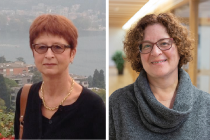Language Science Lunch Talks
The role of early experiences on the neurobiology of language and literacy development
How do we represent event structure? Insights from behavioral and neural evidence
Colorless green screens zoom enthusiastically: Engaging children in virtual outreach
Erika Exton (HESP), Kathleen Oppenheimer (HESP), Lauren Salig (NACS), and Craig Thorburn (LING)
What Translanguaging Can Tell Us About Bilingual Language Control: Evidence from Spontaneous Codeswitching
Join us for a panel discussion with researchers who transitioned their lab-based research online over the summer.
Arynn Byrd (HESP) is using a web app to remotely administer a sentence-picture matching task with children. The goal of the study is to evaluate if there are differences in how children who speak different dialects use verb knowledge to disambiguate the sentence. Her web app displays pictures, plays audio, and gathers reaction times and accuracy using the child's tablet.
This semester we're taking a break from the usual Language Science Lunch Talks to reimagine what we can do with this weekly opportunity for interdisciplinary discussion. We want to create an environment where all members of our community feel comfortable expressing ideas, learning to communicate with people from different discpiplines, and maintaining relationships with peers from other departments. We recognize that the traditional academic talk format may not be the best way to achieve these goals.
Julianne Garbarino (HESP): How do disfluencies relate to early grammatical errors?
Abstract: Children usually begin to stutter between ages 2.5 and 3.5-- a period when their expressive language includes many errors when compared to adult models. This talk will explore the relationship between grammatical errors in children's early language and the production of stuttering-like and non-stuttered disfluencies.







